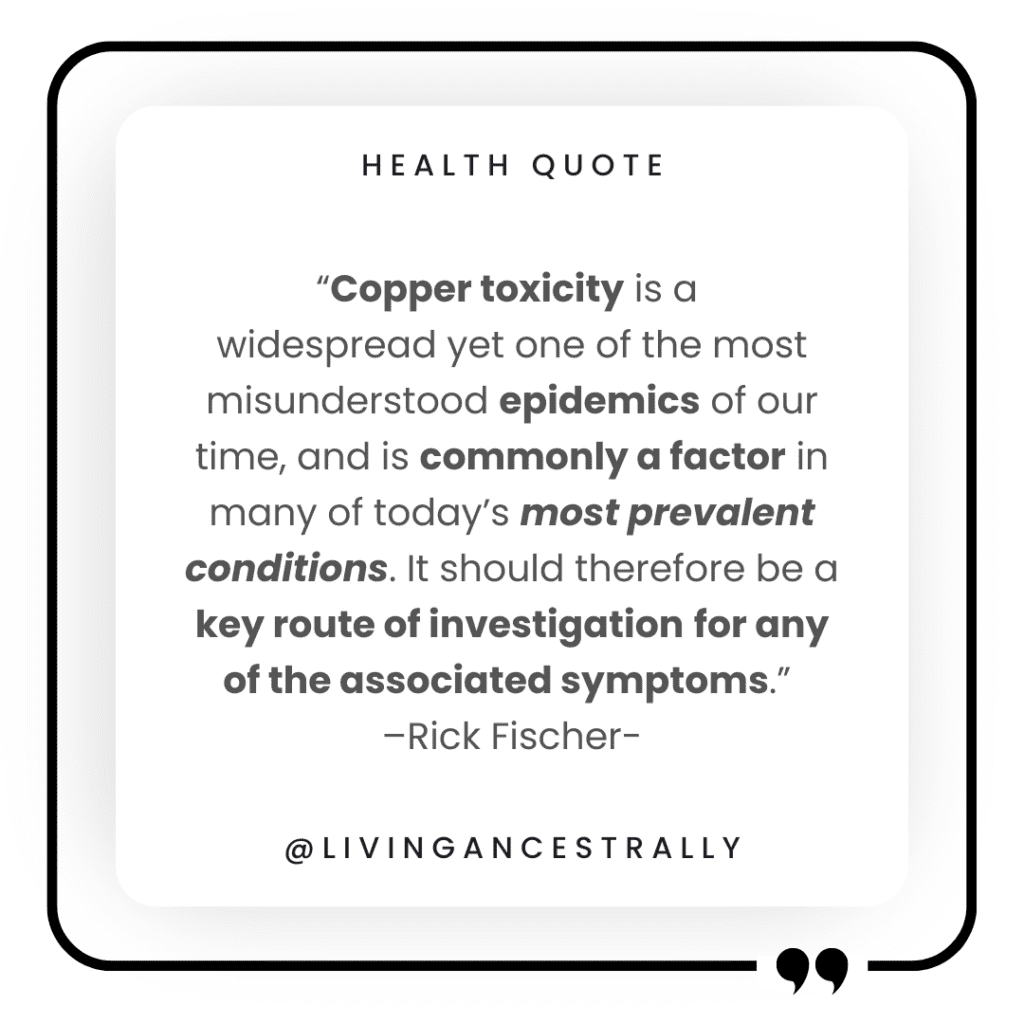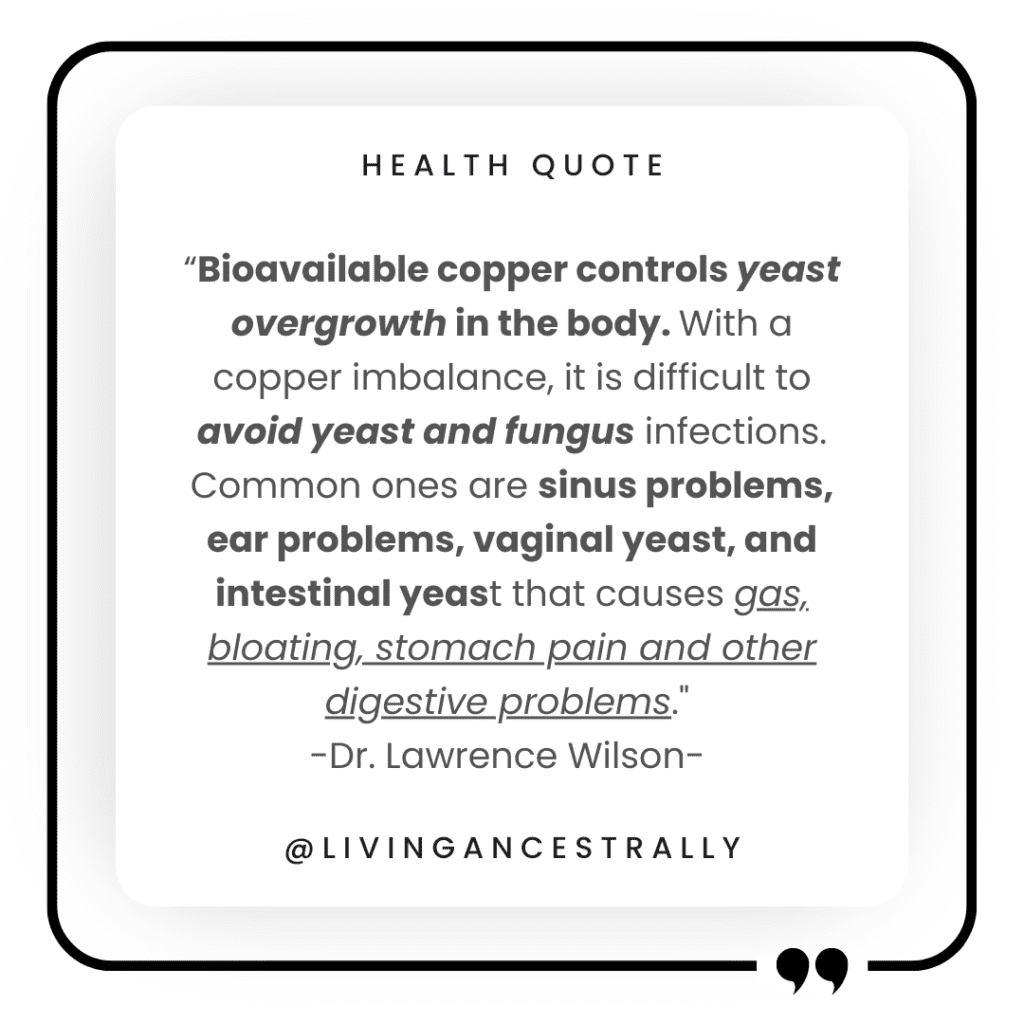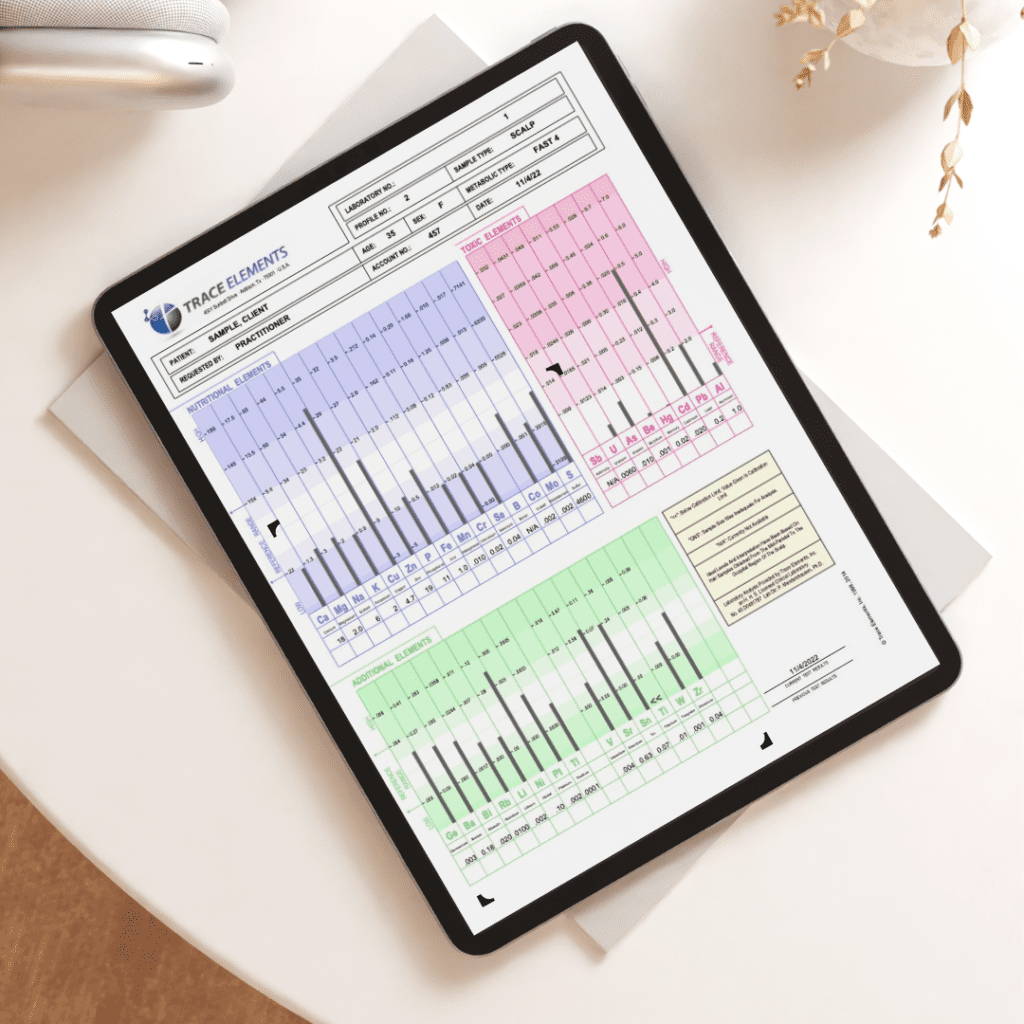If you feel like you’re constantly battling brain fog, chronic fatigue, or candida overgrowth, then chances are you may be experiencing copper toxicity. This is becoming a more common issue in the world today due to environmental exposures such as swimming pools and copper pipes, as well as dietary changes like veganism and vegetarianism which can lead to a copper-to-zinc imbalance. In this article, we will discuss why it’s important to balance your copper-to-zinc ratio and how to do it in order to cut through the copper fog.

What is a Copper Imbalance?
Copper toxicity is a condition that occurs when excessive amounts of bio-unavailable copper accumulate in the vital organs, causing various health issues.
Copper is an essential trace mineral necessary for survival. It is found in all body tissues and plays a crucial role in making red blood cells, maintaining nerve cells, and supporting the immune system.
However, like with all things, copper must be in balance. When there are mineral imbalances of any sort, health issues will eventually develop.
What are the Causes of Copper Toxicity?

How to Spot Copper Toxicity
Copper toxicity also referred to as copper overload, can cause a range of symptoms impacting different body systems.
The severity of these symptoms can vary, from subtle to severe, underscoring the importance of early recognition for accurate diagnosis and management.
Copper toxicity often causes oxidative stress and damages cells. In severe cases, this mineral imbalance may be life-threatening.
Common Signs and Symptoms

• Stomach Issues: Too much copper irritates the stomach and can lead to nausea, vomiting, abdominal pain, and diarrhea.
• Brain Effects: When copper accumulates in the brain, it can cause headaches, dizziness, difficulty concentrating, ADHD, and in severe cases, tremors, memory problems, and psychosis.
• Mood Changes: Due to copper’s emotional nature, individuals with copper toxicity often exhibit emotional symptoms such as anxiety, depression, irritability, and mood swings. These symptoms are very common in children who have a copper imbalance.
• Fatigue and Weakness: Having too much copper can make you feel tired all the time, weak, and lacking energy for everyday activities.
• Liver Troubles: Excessive copper can harm the liver, causing jaundice, liver pain, and increased liver enzyme levels in blood tests.
• Anemia: Copper toxicity can cause a specific type of anemia called hemolytic anemia, leading to fatigue, paleness, and difficulty breathing.
• Skin Problems: Rashes, itching, and the appearance of reddish-brown spots called petechiae are common skin issues associated with copper toxicity. Cellulite and white spots on the nails are other common issues.
• Joint Pain: People with copper toxicity may experience joint pain and inflammation similar to arthritis symptoms.
• Yeast Overgrowth: Excessive copper and too little zinc can be a cause of a chronic candida overgrowth issue. Balancing these two essential minerals is important in overcoming this damaging and annoying health issue.
It’s helpful to keep in mind that these signs and symptoms can be similar to other health conditions.

If you suspect copper toxicity or have persistent health problems, consult a health professional for accurate diagnosis and appropriate treatment.
Keep reading to see how a hair tissue mineral analysis might be your best tool for detecting copper toxicity or other mineral imbalances.
Diagnosing Copper Toxicity
Hair Tissue Mineral Analysis (HTMA) proves to be a highly effective tool for assessing copper toxicity, as well as heavy metals, for several reasons.
✔️ An HTMA test provides a longer-term picture of mineral retention and metabolic activity. Unlike blood tests that show the condition of your body at a particular moment, hair tissue mineral analysisgives insights into your body’s mineral levels and heavy metals accumulated over a period of time. This is particularly useful in the case of copper, which can accumulate in tissues and organs over several years and may not always be detectable in blood or urine tests.
✔️ Hair testing is non-invasive. Hair samples are collected in the comfort of your own home. The hair samples are then mailed to an accredited lab that offers hair testing. Trace Elements Inc. and Analytical Research Labs are both excellent labs that properly handle hair samples.

An HTMA test is an excellent option for not only adults but children as well. Hair tissue mineral analysis testing has been used for over 40 years. While there are certainly some critics of this type of mineral testing there is a lot of research to back up its use and benefits.
The non-invasive nature of a hair analysis makes it an ideal tool for regular monitoring of copper levels, thus enabling early detection and treatment of copper toxicity as well as mineral imbalances in general.
Benefits of A Hair Tissue Mineral Analysis to Check Overall Mineral Status
An HTMA test is not just limited to assessing copper toxicity. It provides a comprehensive analysis of the overall mineral content and heavy metals that are stored in the body. This holistic view is vital as copper toxicity often doesn’t exist in isolation.
Copper often interacts with other minerals and heavy metals, exacerbating or mitigating the toxic effects.
By providing this broader perspective, an HTMA test allows for a more accurate and comprehensive approach to addressing copper toxicity.
How to Collect a Hair Sample for the HTMA Test
A hair mineral analysis allows health professionals to customize assessments based on individual mineral patterns and ratios, providing personalized recommendations for treatment and diet. Be sure that they also take your health history and exposure history into account.
Be sure that your certified or licensed hair analysis practitioner has knowledge and experience in analyzing the mineral content and heavy metals like mercury, aluminum, and arsenic in the body. By doing so, you’ll get a more accurate assessment and effective management of copper toxicity and associated health problems.

Steps for Collecting Your Hair Samples:
It is best to use scalp hair for the most accurate results. Be sure that your hair is free of hair dyes for 8 weeks before you collect your sample. Wash your hair with a non-residue shampoo 24 hours prior to the sample collection. Avoid using any beauty products like conditioner, hair spray, or gel after washing.
1. To collect the sample, use stainless steel scissors to cut small amounts of hair from the nape of the neck or other hidden areas until you have a sample that is about 1-1.5 inches of new hair growth. It really is a small sample of hair! You probably need less than you think. Your HTMA test kit should come with a scale that you can use to weigh your hair sample.
2. Place the collected sample in the envelope provided in the hair collection kit. Remember to handle the sample with clean hands and avoid touching the inside of the envelope.
3. Fill out the hair sample submission form, which typically includes personal information and health history.
4. Mail the envelope containing the hair sample, along with the completed submission form, to the laboratory specified in your hair testing kit. Ensure the envelope is sealed properly to prevent any contamination.
5. Await your test results, which should arrive via email or postal service from your hair analysis practitioner within a few weeks. Follow up with your practitioner to discuss your test results, as well as any necessary steps for treatment or further testing.

Importance of Balancing Copper with Zinc
After you’ve gotten an HTMA test to check for copper toxicity as well as other essential minerals and heavy metals, you’ll want to ask your HTMA practitioner about the copper-to-zinc ratio if copper looks high on your test results.
Understanding the copper-to-zinc ratio is essential as it provides insight into your overall health, particularly because copper and zinc are two vital minerals that play significant roles in the body.
What Do Copper and Zinc Do In The Body?
Copper and zinc are essential minerals that interact with each other and help accomplish several biological functions.
For example, zinc is crucial for the proper function of the immune system, wound healing, protein synthesis, and DNA synthesis. Copper aids in the formation of red blood cells, maintaining nerve cells and supporting the immune system.
However, an imbalance between copper and zinc levels can lead to health complications.
If the copper-to-zinc ratio is too high, meaning there is too much copper in relation to zinc, it can result in copper toxicity. This can lead to the signs and symptoms mentioned above.
On the other hand, if the ratio is too low, it indicates a zinc overload, which can suppress the immune system and cause a decrease in good cholesterol. As you can see, maintaining a balance between these two minerals is crucial for our health.
How Can We Balance the Copper-to-Zinc Ratio?
✔️ Eating Habits: Consuming a whole-food diet rich in zinc and other essential minerals can help balance the copper-to-zinc ratio. Foods such as oysters, beef, chicken, pork, pumpkin seeds, yogurt, and mushrooms are high in zinc. Reducing the intake of foods high in copper like shellfish, whole grains, beans, nuts, potatoes, and organ meats can also aid in balancing the ratio.

✔️ Targeted Supplementation: Under the guidance of a health professional who has assessed your hair analysis, taking zinc supplements can help adjust the copper-to-zinc ratio. Zinc supplements can increase zinc levels and simultaneously reduce copper levels as these two elements compete for absorption in the body. Oftentimes, adding a zinc supplement at the start of a protocol is not advisable. The macro-minerals, also known as potassium, calcium, magnesium, and sodium normally need to be balanced first before trace minerals are supplemented.
✔️ Limit Exposure to Copper: Reducing exposure to sources of environmental copper such as unfiltered water, copper pipes, and copper cookware can also help maintain a balanced copper-to-zinc ratio. It’s important to drink filtered or bottled water if your water supply runs through copper pipes.

Importance of Testing for Mineral Imbalances
The copper-to-zinc ratio is a crucial biomarker of health and wellness, often overlooked in standard medical tests.
The majority of practitioners are unaware of this important ratio. However, an optimal balance between these two trace minerals is essential for various bodily functions.
Zinc, known for its immune-boosting properties and role in wound healing and sensory functions, often competes with copper for absorption in the body.
While copper assists with energy production, iron metabolism, and brain development. As already discussed, an excess of copper can inhibit zinc absorption, leading to a host of health issues.
As you may notice, maintaining a balanced copper-to-zinc ratio is pivotal in ensuring optimal health and preventing conditions like immune disorders, neurodevelopmental disorders, and cardiovascular diseases.
As a certified hair tissue mineral analysis (HTMA) practitioner, I recommend regular hair analysis testing and monitoring of not only the copper-to-zinc ratio but all the essential minerals and heavy metals that are stored in the body over a period of time.
Consistent retests help check for excess minerals as well as any deficiencies that could develop with prolonged supplementation.
Until mineral balance is achieved, I regularly order hair analysis tests for clients every three months so we can address mineral imbalances through changes in their whole food intake as well as targeted supplementation that addresses their mineral health.
Conclusion
The copper-to-zinc ratio is a relatively simple yet powerful metric that provides deep insights into our overall health. It underlines the importance of maintaining a delicate mineral balance in our bodies, which is crucial for a plethora of physiological functions.
A hair tissue mineral analysis (HTMA) can assess your mineral status and guide you towards the necessary dietary changes and targeted supplementation to achieve optimal mineral balance, including a healthy copper-to-zinc ratio.
As an HTMA practitioner, I’m committed to assisting you on this journey towards optimal health and wellness, every step of the way.

References:
- Anant, J., Inchulkar, S.R., Bhagat, S. (2018). An Overview of Copper Toxicity Relevance to Public Health. European Journal of Pharmaceutical and Medical Research. Retrieved from https://www.researchgate.net/profile/Jagdish-Anant-2/publication/329125485_Copper_Toxicity/links/5bf6c99792851c6b27d3fde0/Copper-Toxicity.pdf
- Ashish, B., Neeti K., & Himanshu K. (2012). Copper Toxicity: A Comprehensive Study. Research Journal of Recent Sciences. Retrieved from http://www.isca.me/rjrs/archive/v2/iISC-2012/12.ISCA-ISC-2012-4CS-93.pdf
- Badiye, A. (2013). Copper Toxicity: A Comprehensive Study. Research Journal of Recent Sciences, 2(ISC-2012), 58-67.
- Casdorph, H.R., & Walker, M. (1995). Toxic Metal Syndrome. Avery Publishing.
- Eck, P., & Wilson, L. (1989). Toxic Metals in Human Health and Disease. Eck Institute of Applied Nutrition and Bioenergetics Ltd.
- Eck, P., & Wilson, L. (1989). Copper Toxicity (1st edition). Eck Institute of Applied Nutrition and Bioenergetics, Ltd. Pages 1-2.
- Environmental Protection Agency. (1979). Toxic Trace Metals in Human and Mammalian Hair and Nails (Report No. EPA-600 4.79-049). US Environmental Protection Agency, Research and Development.
- Lukac, N., & Massanyi, P. (2007). Effects of Trace Elements on the Immune System. Epidemiology, Microbiology, and Immunology, 56(1).
- Pfeiffer, C., & Mailloux, R. (1987). Excess Copper as a Factor in Human Diseases. Journal of Orthomolecular Medicine, 2(3), 171-182. Retrieved from http://orthomolecular.org/library/jom/1987/pdf/1987-v02n03-p171.pdf
- Watts, D.L. (1990). Trace Elements and Neuropsychological Problems as Reflected in Tissue Mineral Analysis (TMA) Patterns. Journal of Orthomolecular Medicine, 5(3), 159-166. Retrieved from http://www.orthomolecular.org/library/jom/1990/pdf/1990-v05n03-p159.pdf
- Watts, D.L. (1990). Nutrient Interrelationships Minerals — Vitamins — Endocrines. Journal of Orthomolecular Medicine, 5(1), 11-16. Retrieved from http://www.orthomolecular.org/library/jom/1990/pdf/1990-v05n01-p011.pdf
- Wilson, L. (2010). Nutritional Balancing and Hair Mineral Analysis. L.D. Wilson Consultants.
Please note that A Hair Mineral Analysis (HTMA) is not intended to diagnose, treat, cure, reverse, or prevent any disease. It is not intended to replace any other medical test(s) that may be prescribed by your medical doctor.
